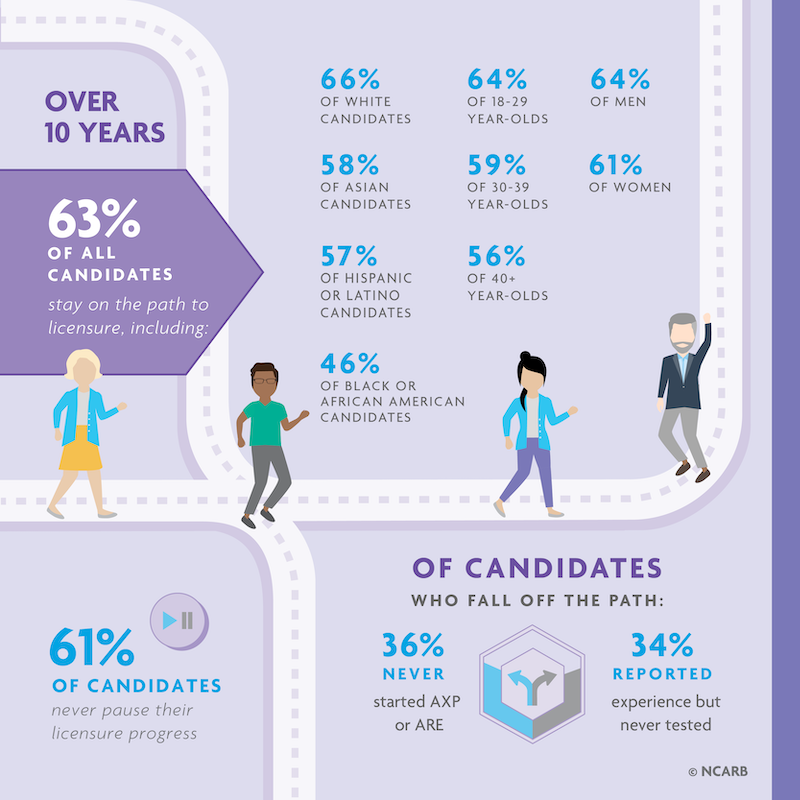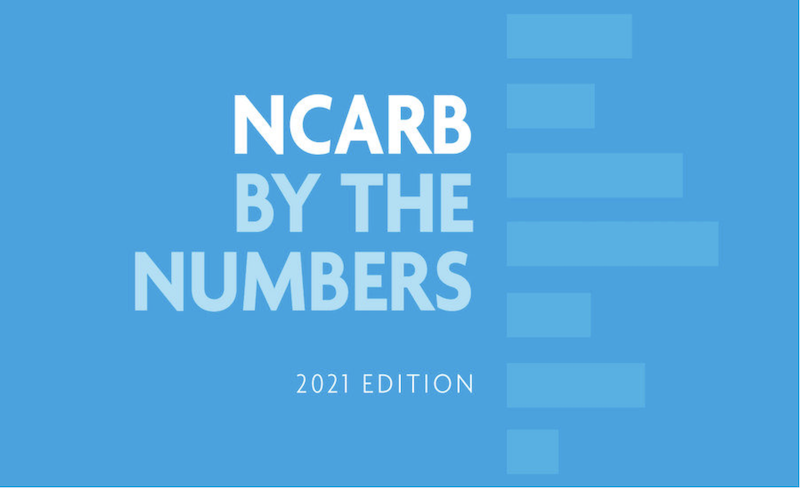On its 10th year of publishing information about its licensing exams, the National Council of Architectural Registration Boards (NCARB) for the first time has released a new section in the 2021 edition of its Architect Registration Examination that breaks down the pass rate by several demographic categories.
The six-part exam is required by all 55 NCARB jurisdictions in the U.S. for candidates seeking architectural licensure. More than 32,700 people took the test, and here are some of the key findings:
•White candidates’ pass rate is higher than that of candidates of color. The disparity is most pronounced in the Programming & Analysis division of the test that focuses on evaluating a project’s requirements and constraints; white candidates’ pass rate was 38 percentage points higher than their Black peers’.
•Men, in general, outperform women candidates on five of the exam’s six divisions. When factoring in race and ethnicity, Black women fare better on the test than Black male candidates.
•Candidates ages 18-29 have the highest pass rates across all six divisions. Candidates 40 years or older have the lowest rate.
Alfred Vidaurri Jr., FAIA, NCARB, AICP, who was inducted as NCARB’s president in June, stated that the findings were both unsurprising and unacceptable. “I challenge us to do better” he said of the industry, adding that he would concentrate on addressing these disparities during his tenure leading the organization.
The hardest part is getting some candidate groups to the finish line. NCARB reports that 63% of all candidates stay on their paths to licensure over 10 years, but that drops off to 61% for women candidates, 58% for Asian candidates, 57% for Hispanics, and 46% for Blacks.
NCARB WILL OFFER FREE PRACTICE TESTS

The report cites disparities in the rate of candidates pursuing licensure.
After commissioning an independent bias study of its exam, NCARB concluded that individual questions don’t drive disparities in candidates’ performance, and that the organization alone can’t resolve inequity in exam access and performance. “Coupled with NCARB’s data on career attrition, these studies suggest that pass rate disparities could also be impacted by access to education and professional experiences,” the organization stated.
Nevertheless, NCARB’s teams have been working to understand the causation of testing disparities, and the organization has pledged to launch the following changes, resources, and opportunities for feedback:
•For the first time in NCARB history, exam candidates have been appointed to the 2021 Examination Committee, which is responsible for recommending format and policy changes to NCARB’s national Board of Directors.
•NCARB is developing free practice tests for all six divisions, with a goal of offering the new suite of resources in mid-2022. (According to NCARB and the National Organization of Minority Architects’ joint Baseline on Belonging study, nearly half of respondents spent more than $500 on test prep materials.)
•NCARB is currently conducting another external audit of its exam, this time focused on the content areas to identify potential trends related to disparate pass rates.
•In addition to NCARB’s annual Think Tanks for emerging professionals and the upcoming Analysis of Practice study, the organization will launch two outreach initiatives in 2021-2022: licensure candidate focus groups conducted by an external consultant; and an Architecture Licensing Feedback survey, where the architect community can share their experience and recommendations.
•In 2019, NCARB launched an internal work group and commissioned external consultants to study licensure programs through an Equality, Diversity, and Inclusion lens. This effort is currently exploring potential links between exam performance and the criteria driving candidates’ Architectural Experience Program® (AXP®) reports, as well as firm culture.
The organization intends to release more details about these initiatives in the coming months.
Related Stories
K-12 Schools | Apr 10, 2024
Surprise, surprise: Students excel in modernized K-12 school buildings
Too many of the nation’s school districts are having to make it work with less-than-ideal educational facilities. But at what cost to student performance and staff satisfaction?
Industrial Facilities | Apr 9, 2024
Confessions of a cold storage architect
Designing energy-efficient cold storage facilities that keep food safe and look beautiful takes special knowledge.
Cultural Facilities | Apr 8, 2024
Multipurpose sports facility will be first completed building at Obama Presidential Center
When it opens in late 2025, the Home Court will be the first completed space on the Obama Presidential Center campus in Chicago. Located on the southwest corner of the 19.3-acre Obama Presidential Center in Jackson Park, the Home Court will be the largest gathering space on the campus. Renderings recently have been released of the 45,000-sf multipurpose sports facility and events space designed by Moody Nolan.
Green | Apr 8, 2024
LEED v5 released for public comment
The U.S. Green Building Council (USGBC) has opened the first public comment period for the first draft of LEED v5. The new version of the LEED green building rating system will drive deep decarbonization, quality of life improvements, and ecological conservation and restoration, USGBC says.
Codes and Standards | Apr 8, 2024
Boston’s plans to hold back rising seawater stall amid real estate slowdown
Boston has placed significant aspects of its plan to protect the city from rising sea levels on the actions of private developers. Amid a post-Covid commercial development slump, though, efforts to build protective infrastructure have stalled.
Sustainability | Apr 8, 2024
3 sustainable design decisions to make early
In her experience as an architect, Megan Valentine AIA, LEED AP, NCARB, WELL AP, Fitwel, Director of Sustainability, KTGY has found three impactful sustainable design decisions: site selection, massing and orientation, and proper window-to-wall ratios.
Brick and Masonry | Apr 4, 2024
Best in brick buildings: 9 projects take top honors in the Brick in Architecture Awards
The Ace Hotel Toronto, designed by Shim-Sutcliffe Architects, and the TCU Music Center by Bora Architecture & Interiors are among nine "Best in Class" winners and 44 overall winners in the Brick Industry Association's 2023 Brick in Architecture Awards.
Retail Centers | Apr 4, 2024
Retail design trends: Consumers are looking for wellness in where they shop
Consumers are making lifestyle choices with wellness in mind, which ignites in them a feeling of purpose and a sense of motivation. That’s the conclusion that the architecture and design firm MG2 draws from a survey of 1,182 U.S. adult consumers the firm conducted last December about retail design and what consumers want in healthier shopping experiences.
Healthcare Facilities | Apr 3, 2024
Foster + Partners, CannonDesign unveil design for Mayo Clinic campus expansion
A redesign of the Mayo Clinic’s downtown campus in Rochester, Minn., centers around two new clinical high-rise buildings. The two nine-story structures will reach a height of 221 feet, with the potential to expand to 420 feet.
Sports and Recreational Facilities | Apr 2, 2024
How university rec centers are evolving to support wellbeing
In a LinkedIn Live, Recreation & Wellbeing’s Sadat Khan and Abby Diehl joined HOK architect Emily Ostertag to discuss the growing trend to design and program rec centers to support mental wellbeing and holistic health.

















